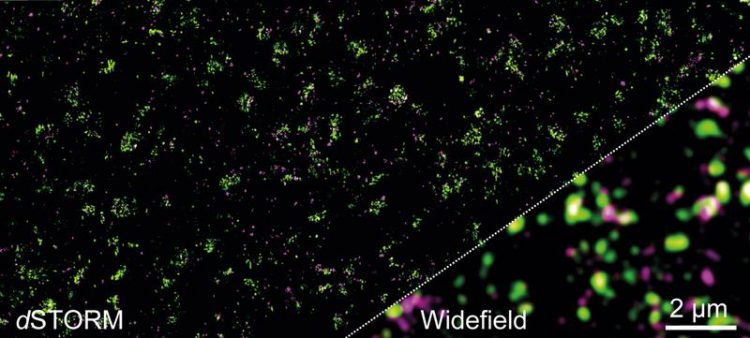Insight Into the Synapses

The glutamate receptor mGluR4 and other proteins in the presynaptic membrane. Left: a super-resolution image. Right: conventional fluorescence microscopy – molecular details are not visible here. Picture: Chair Markus Sauer / University of Würzburg
When people think of glutamate, the first thing they remember is the flavour enhancer that is often used in Asian cuisine. Glutamate is also an important messenger substance in the nervous system of humans.
There it plays a role in learning processes and memory. Some Alzheimer drugs, for example, slow down the progression of the disease by inhibiting the effect of glutamate.
In the nervous system, glutamate acts as a signal transmitter at the synapses. There, it binds to specific receptors of which there are several types. The metabotropic glutamate receptor of type 4 (mGluR4) plays a decisive role in this system.
Direct contact to other proteins
Until now, not much was known about the distribution of this receptor in the active zones of synapses. It is now clear that the majority of mGluR4 receptors are located in groups of one to two units on average in the presynaptic membrane.
There they are often in direct contact with calcium channels and the protein Munc-18-1, which is important for the release of messengers.
This is reported in the journal Science Advances by a research team led by Professor Markus Sauer from the Biocenter of Julius-Maximilians-Universität (JMU) Würzburg in Bavaria, Germany, and Professor Davide Calebiro from the University of Birmingham in England.
“Our data indicate that the direct contact of mGluR4 receptors with other key proteins plays a major role in the regulation of synapse activity,” says Professor Sauer.
Active zones are densely packed
The new knowledge was gained with the super-resolution microscopy method dSTORM (direct stochastic optical reconstruction microscopy). The method was developed by Sauer's team in 2008. It enables individual molecules to be located even in the very small and densely packed active zones of synapses. This is not possible with conventional light microscopy because of the diffraction limit of 200 nanometers.
“For the first time we now have insights into the molecular organisation of the complex protein machines that control the signal transmission at the synapses of our brain,” says Professor Calebiro. Only with this knowledge will we be able to understand how the brain functions and how it processes information on different time scales.
The research teams will now use dSTORM to find out how all the proteins are distributed in the active synaptic zone. It is generally assumed that more than 100 proteins are involved in signal transmission in the active zones.
Funding of the research
This research was funded by the German Research Foundation, the Wellcome Trust, the German Excellence Initiative and the German Academic Exchange Service.
Prof. Dr. Markus Sauer, Chair of Biotechnology and Biophysics, University of Würzburg, T +49 931 31-88687, m.sauer@uni-wuerzburg.de
Super-resolution imaging reveals the nanoscale organization of metabotropic glutamate receptors at presynaptic active zones, Science Advances, 15th April 2020, DOI: 10.1126/sciadv.aay7193
https://www.biozentrum.uni-wuerzburg.de/super-resolution/publications/markus-sau… Website Markus Sauer
Media Contact
More Information:
http://www.uni-wuerzburg.deAll latest news from the category: Life Sciences and Chemistry
Articles and reports from the Life Sciences and chemistry area deal with applied and basic research into modern biology, chemistry and human medicine.
Valuable information can be found on a range of life sciences fields including bacteriology, biochemistry, bionics, bioinformatics, biophysics, biotechnology, genetics, geobotany, human biology, marine biology, microbiology, molecular biology, cellular biology, zoology, bioinorganic chemistry, microchemistry and environmental chemistry.
Newest articles

New theory reveals the shape of a single photon
A new theory, that explains how light and matter interact at the quantum level has enabled researchers to define for the first time the precise shape of a single photon….

Perovskite research boosts solar cell efficiency and product life
An international team led by the University of Surrey with Imperial College London have identified a strategy to improve both the performance and stability for solar cells made out of…

Neuroscientists discover how the brain slows anxious breathing
Salk scientists identify brain circuit used to consciously slow breathing and confirm this reduces anxiety and negative emotions. Deep breath in, slow breath out… Isn’t it odd that we can…



